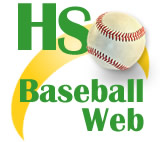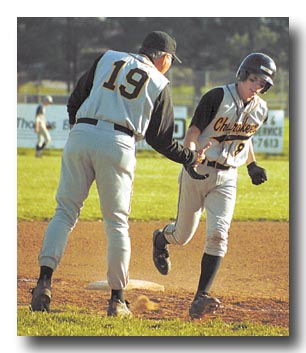 |
|
High School Baseball Web
 |
|
|
The High School Baseball Web -
An internet home for high school baseball players, coaches, parents and
fans.
If you like what you see please tell others about the site. If you
have comments
or suggestions you can send them to us using the "Contact" link below.
|
|
|
|
| |
  
|
| |
 |

|
|
|
|
|
Basic Fundamentals of Baseball
Coach David Ray
McMinn County High School
Athens, Tennessee
Do you want to give your child everything he needs to succeed as a
baseball player? Good! Then don't overlook the most important aspect --
Teach them the basic fundamentals when they are small. Too often a
young player's natural athletic abilities will compensate for a lack
of fundamental skills.

To have success in Baseball, young players must be taught the proper
techniques. This paper will deal with the proper teaching methods and
drills for throwing, catching (fielding), and hitting. Most of these
fundamentals can be learned at an early age. They can also be improved
upon if the basic techniques are taught correctly.
- The basic skills of hand-eye coordination and throwing correctly
must be taught and practiced around the age of 5. Proper throwing and
a strong arm can be learned. It must, however, begin at a young age.
When the child is 5-6 years of age, proper throwing skills can be
taught. It is recommended that a plastic ball be used and make sure
the child does 3 things: 1) throw with an overhand motion, 2) turn
the shoulders perpendicular to the target, 3) step with the proper
foot (left foot for right-hander and vice versa). The only way to
develop an accurate and strong arm is through repetition.
- Between the ages of 7-9, games should be incorporated into
throwing practice to make it fun and challenging: "longest throw",
(after proper warm-up), "hit the target", "count the throws", etc.
Use your imagination and create enthusiasm while your child is
practicing his throwing. A "soft" baseball should be used for 7 & 8
year olds and a real baseball beginning with age 9. It is also
recommended that the balls be smaller in size in order that the
young child learn the proper grip: 2 or 3 fingers on top with the
thumb directly under the ball.
- Children between the ages of 10 - 12 should begin practice with
the "long toss" drill. Throwing long is the best way to improve and
strengthen the throwing arm. After proper warm - up, the thrower
should begin backing up and make a few long throws to his partner.
It may be necessary to "crow hop." This means the thrower will use
his legs by taking an extra "hop" before he throws. See who can
throw it the farthest. This drill develops arm strength with an
emphasis on the loose arm.
- No one under the age of 12 - 13 should ever experiment with
curveballs, sliders, split fingers, or knuckleballs. These pitches
put added pressure and strain on the elbow and are dangerous for
the young players. Work on arm strength, accuracy, and the "loose
arm" by throwing fastballs.
- Catching and fielding drills can be taught and practiced
simultaneously with throwing. Begin the 5 - 6 year old by catching
the plastic ball with 2 hands (no glove). The child will not be
ready for a glove until he can catch the plastic ball consistently
with 2 hands. Hand - eye coordination can be improved by playing
catch with a plastic ball, a basketball, a balloon, or by the child
throwing the ball up into the air and catching it with both hands.
Ping pong, tennis, badminton, and volleyball are other games which
require good hand - eye coordination. Use these games as teaching
aids. Don't be afraid to use your imagination and make up games to
teach and improve hand - eye coordination or other necessary skills.
- Ground ball technique should begin after the child becomes adept
at catching throws with his glove and can physically handle the glove.
A smaller glove should be used in order that the child control it
as if it were an extension of his hand. Do not allow the child to
use the "bigger glove" because the child will become dependent on
his glove and will not develop good "soft hands." Proper control
of the glove is very important. Begin by rolling ground balls to
the child on a hard surface. Have the child field the grounders
without a glove and use the "alligator" technique. The alligator
technique means that the infielder puts his glove hand on the
ground with his throwing hand on top about 12 inches from the
glove (like an alligator's mouth). Be sure not to block the eyes
as they follow the ball into the glove. This free top hand will
offer protection to the child's face in case of a bad hop.
Fear is an enemy to all young infielders. Avoid this fear by
protecting the face with the throwing hand and protect the private
parts with a cup. The feet should be about shoulder width apart
and form a triangle with the feet and the glove. Make sure he
catches the ball out in front and then bring the ball and both
hands to the belly. His eyes should follow the ball to the belly
and the coach should be able to see the "bean" on the top of the
hat. After many repetitions, the child will be ready to correctly
field a groundball (with or without a glove) and use the alligator
technique.
Wall Ball: The infielder can practice the proper groundball
technique by throwing himself groundballs against a wall. Catch the
groundball as it caroms off the wall. Work on short hops, back-hands,
and fore-hands.
Paddle Drill: The infielders should practice catching
groundballs using a wooden glove. This requires the infielder
to use 2 hands and have "soft" hands (the hands should give as
if he's catching an egg). Flyballs can be taught in a similar
fashion by starting without a glove. The plastic balls should be
caught with 2 hands over the throwing shoulder.
A glove may be used only after the child demonstrates the proper
technique. The best practice drill is for the child to throw the
ball up into the air by himself. Get the child to count these throws
to see how many times he can catch it without a miss. The parents
or coach can assist the child by throwing flyballs in a way that
makes him demonstrate proper techniques. Eventually, the child
will be ready to catch some flyballs hit off the fungo bat. Do
not hit flyballs with the fungo bat until the child is ready.
Coach Ray has other articles on his team's website:
McMinn County Baseball
|
|
|